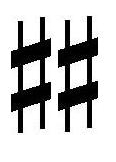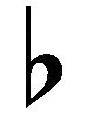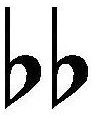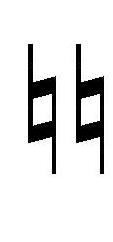5.1 Sharps, Flats and Naturals
The sharp, flat and natural signs raise or lower the pitch of the notes to which they apply:
| Sharp |  |
raises the pitch of a note by a semitone |
| Double sharp |


|
raises the pitch of a note by two semitones |
| Flat |  |
lowers the pitch of a note by a semitone |
| Double flat |  |
lowers the pitch of a note by two semitones |
The Natural sign is used to restore a note to its original pitch. It also cancels double flats or double sharps but, for the greatest clarity, these are often cancelled by a double natural sign.
The natural and double natural are written as follows:
| Natural |  |
| Double natural |  |
These symbols may be used in three ways: as Accidentals, as Precautionary Accidentals or in Key Signatures
Accidentals in Braille
5.2 Accidentals
Accidentals are sharp, flat or natural signs used in the course of a piece. Once an accidental appears in a bar it applies to the note on that line or space for the rest of the bar but it does not apply to notes in other octaves.
An example of the use of accidentals

Braille example
An example of the use of double accidentals

Braille example with dobled accidentals
To change a double flat to a single flat the natural sign and the flat sign are used together (see bar 1 of the following example).
To change a double sharp to a single sharp the natural sign and the sharp sign are used together (see bar 2 of the following example).

Braille example
If a note with an accidental is tied over the bar line the accidental does not need to be written again. The accidental remains in force for the duration of the tied note. Note that, in the following example, the G# on beat 2 of the second bar needs a sharp sign.

If the G on beat 1 of bar 2 in the previous example is intended to be a natural then the natural sign must be written. In this case, of course, the line connecting them must be interpreted as a slur.

If a note with an accidental is tied across two lines of music then it is necessary for the accidental to be written again.

Braille examples alteration and tie
5.3 Precautionary accidentals
If a note has an accidental it only remains in force for the bar in which it appears. Nonetheless it is common to write a precautionary accidental in the following bar if that note appears again. Precautionary accidentals are often enclosed in brackets to show that they are only precautionary.

5.4 Key signatures
A Key Signature is used to indicate the key of a piece of music and is always written immediately after the clef. In the example given below the piece is in the key of B flat major. In this key the notes B and E are always flattened. The key signature therefore consists of flat signs on the B line and the E space of the staff. Note that, although only one B flat and one E flat appear in the key signature, this indicates that all Bs and Es in any octave in the piece are to be flattened

Braille example in b flat major
The key signature is repeated at the beginning of every line of music (in printed music but not in Braille music).
To cancel the effect of a sharp or flat in the key signature a natural sign is used.
Key signatures can have a maximum of seven sharps or flats and these appear in a progression of perfect fifths.
The sharp key signatures start with F# and proceed in the sequence F, C, G, D, A, E, B.
The flat key signatures start with B flat and proceed in the sequence B, E, A, D, G, C, F. Note that this sequence is the reverse of the sequence for the sharps.
The sharp key signatures

Braille example sharp Key signatures
The flat key signatures

Braille example flat Key signatures
